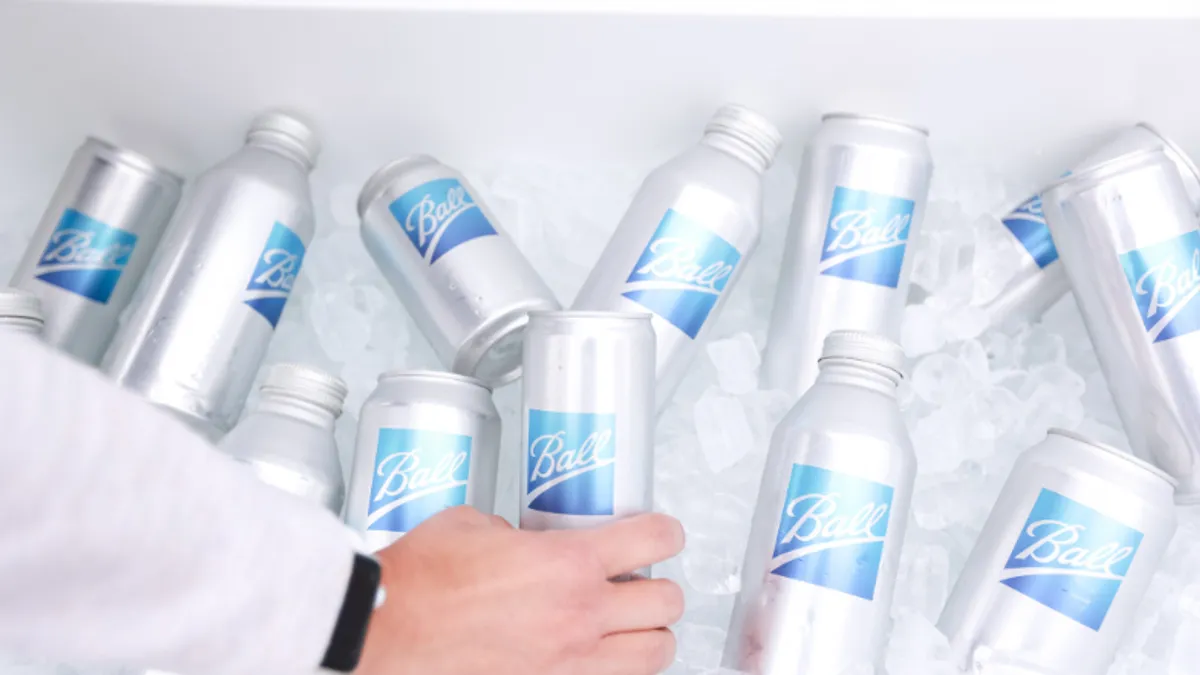Dive Brief:
- Ball is highlighting the benefits of deposit return programs, or “recycling refunds,” alongside extended producer responsibility in a new report analyzing how states with such policies have been able to boost their recycling rates. Ball reported the U.S. recycles 45.2% of aluminum cans.
- Trends point to an overall stagnation or decline in recycling rates since the last report, in part attributed to pandemic-related shutdowns at many recycling centers, as well as “inclusion of new and more accurate data.”
- According to the data, states with recycling refund programs, also known as bottle bills, represent 27% of the U.S. population but account for 47% of all packaging recycled, 51% of all aluminum cans and glass bottles recycled and 61% of all PET bottles recycled.
Dive Insight:
Ball’s own climate targets have it shooting for a 90% recycling rate for aluminum beverage cans, bottles and cups across all markets by 2030. That would help enable 85% recycled content across those products by the same year.
Ball and Eunomia Research & Consulting released the 50 States of Recycling 2.0 report based on 2021 recycling data for aluminum, glass and PET, an updated version of the analysis first released in 2021 with 2018 data. Recycling rates in the report reflect what they describe as “real recycling” — not the material that is collected, but that which is available to be made into new products.
“Having a true assessment of recycling rates will better enable us to understand what policy and program measures are needed to capture more quality material, increasing circularity, reducing our need for virgin materials and thus helping protect the planet,” said Sarah Edwards, CEO for Eunomia North America, in a press release.
Ball notes that nine out of the 10 states with the highest recycling rates have bottle bills in place — all but New Jersey. Bottle bill states recycle 34% of packaging (excluding fiber and flexible plastics) through closed-loop end markets like can-to-can or bottle-to-bottle, nearly five times the rate for non-bottle bill states.
States with highest and lowest recycling rates in 2021*
| Highest | Lowest |
| Maine: 65% | West Virginia: 2% |
| Vermont: 51% | Louisiana: 4% |
| Massachusetts: 48% | Tennessee: 5% |
| Iowa: 45% | Alaska: 6% |
| Oregon: 45% | South Carolina: 6% |
| New York: 44% | Mississippi: 6% |
| California: 41% | Oklahoma: 8% |
| Michigan: 40% | Alabama: 8% |
| New Jersey: 39% | Texas: 8% |
| Connecticut: 39% | Colorado: 11% |
*Excludes fiber and flexible plastics.
Part of the analysis included case studies of how Colorado, for example, could implement its passed EPR law alongside a recycling refund program. Another looks at how Washington, which has considered EPR, could see recycling performance change with EPR alone versus when accompanied by a recycling refund program.
Recycling refund programs can be implemented in two to five years, versus five to eight years for EPR, according to the report. “As we think about companies’ 2030 goals and state climate goals as well, it really appears to be that pairing both those policies together, we'll be able to deliver high recycling rates at a quicker pace that's needed,” said Megan Lane, manager of circularity and public affairs at Ball.
Next steps include working with other industry partners to understand where efficiencies could be realized by implementing both programs together, Lane said. They also need to think about how to serve different segments in the consumer population, to consider people who may rely on same-day refunds as well as middle-income families that might have greater access to vehicles, for example.
The International Aluminium Institute and other trade groups announced a target at COP28 to recycle at least 80% of aluminum beverage cans worldwide by 2030 and nearly all by 2050, getting there through actions such as establishing national or state recycling targets with supportive policies and collecting and publishing more data on can recovery. Ball was among the entities endorsing these actions. Ball this year has been active lobbying regarding the federal Recycling Infrastructure and Accessibility Act, designed to provide recycling services grants, and a federal deposit return system.
Regarding a potential national bottle bill, Lane said Ball “would love to see something like that at the national level, keeping in mind that it's well designed and designed for high performance; one of the key components we also think is it should be industry-run with high performance targets to make sure that the system performs well.”
The data in the 50 States report is important for the industry, Lane said, though Ball prefers a government entity could put out such a report. Ball has not committed to making it an annual report but “it's something we definitely would consider for the future,” Lane said. In the future, more research around operations and cost savings of EPR and recycling refund programs in tandem would be useful, Lane said, as well as insights into how those programs might reduce litter. Modeling litter decreases could be “really compelling” for industry and policymakers, Lane said.
Interested in more packaging news? Sign up for Packaging Dive’s newsletter today.












